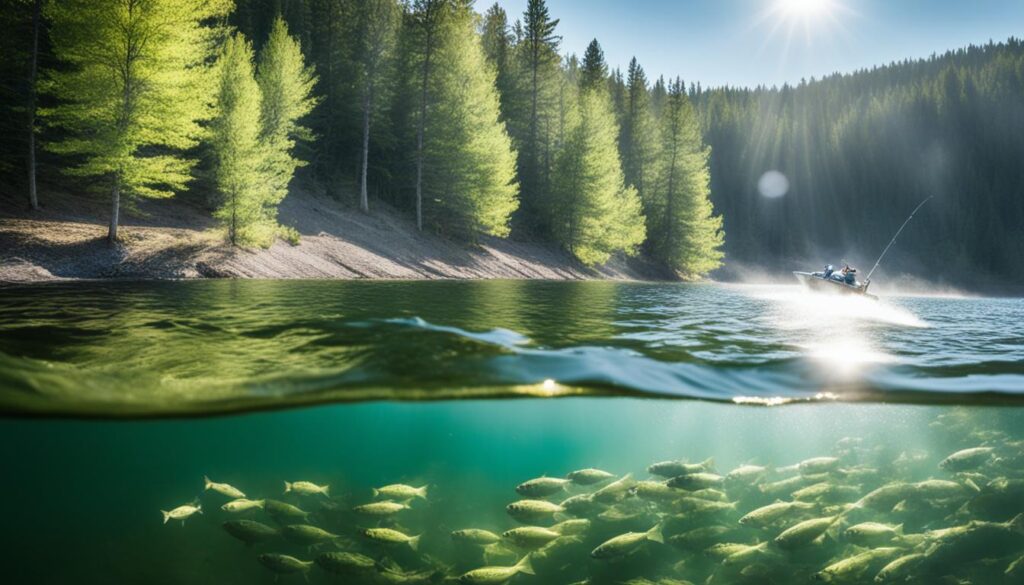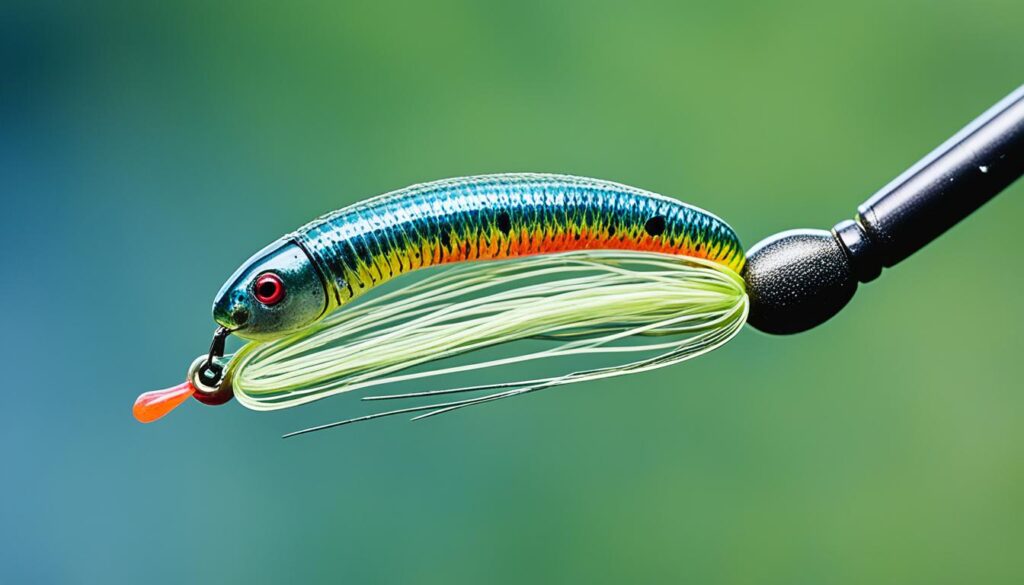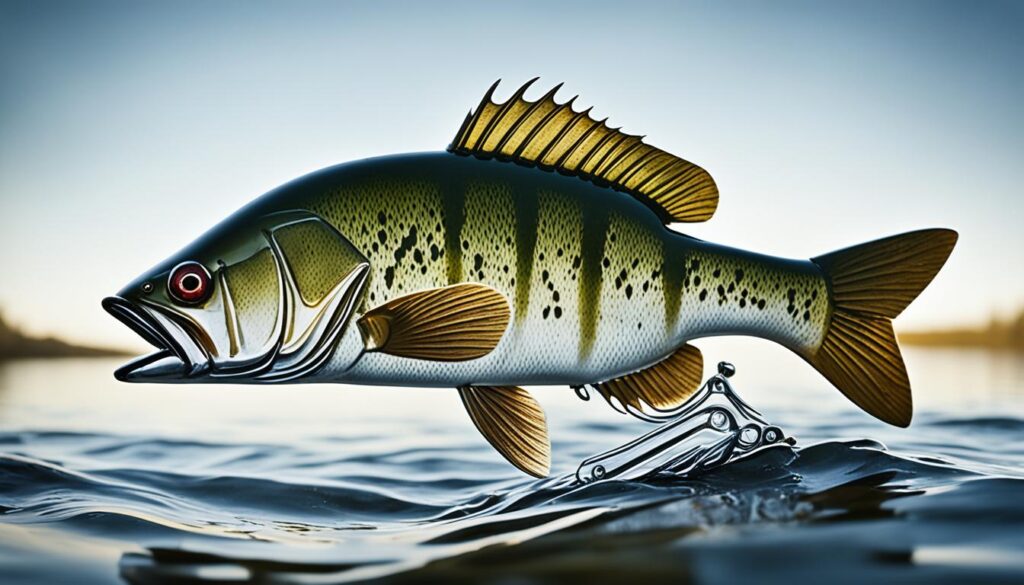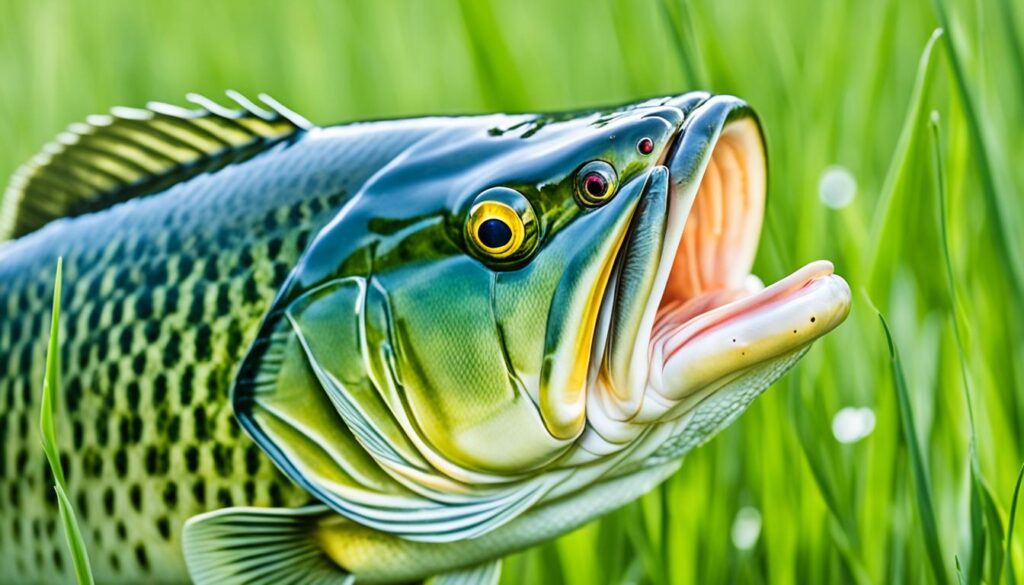Regarding bass fishing, the early pre-spawn period is an exciting time for anglers. As the fish prepare for their annual spawning ritual, they become more active and aggressive, making them easier to target. One practical approach during this time is fishing with worms. Worms imitate natural forage and can entice bass to bite. In this article, titled “Best Baits For Early Prespawn Grass Bass,” I will share some tips and techniques specifically focused on using worms to catch early pre-spawn grass bass.
Key Takeaways:
- Targeting bass in the grass during the early pre-spawn period requires the right approach and bait selection.
- Worms are an excellent choice for enticing bass to bite during this time.
- There are various worm presentations and techniques that can be effective for catching early pre-spawn grass bass.
- Experimenting with different colors and sizes and retrieving speeds can help determine what works best on any given day.
- Adapting to changing conditions and being patient are essential for success when fishing for early pre-spawn grass bass.
Suspending Jerkbaits
Suspending jerkbaits are essential for early spring fishing, excelling at enticing pre-spawn bass near points and humps by spawning areas. The Smithwick Rattlin’ Rogue stands out among these lures.
Suspending jerkbaits stand out for their ability to mimic winter-chilled or dying baitfish, appealing realistically to bass, especially in cooler water. Their subtle rolling action can provoke aggressive strikes from cautious bass.
To maximize their effectiveness, mastering the classic spring jerkbait technique is crucial. Cast beyond your target structure, retrieve quickly, and jerk the rod sharply to create erratic movements resembling injured prey. A brief pause can trigger a reactionary strike from nearby bass.
Experiment with different presens. Adjust retrieve speed, vary jerk cadence, and test pause durations to gauge what attracts the most bites. Bass behavior can be unpredictable, so staying adaptable and open to new techniques is essential for consistent success.
Using suspending jerkbaits in early spring fishing significantly boosts your chances of success. These lures excel at targeting bass near structure during the pre-spawn period. Ensure you have a few suspending jerkbaits in your tackle box, and be ready to adapt your presentation to entice trophy bass effectively.

Lipless Crankbaits
When targeting prespawn bass in lakes with submerged vegetation, lipless crankbaits are a favored choice among anglers. These versatile lures mimic the tight wiggle of winter-chilled baitfish, making them irresistible to hungry bass. Equipped with rattling capabilities, they emit sound and vibrations that attract bass from afar.
A key advantage of lipless crankbaits is their ability to be retrieved just above grass beds at various depths. To effectively use these baits, adjust your retrieve speed and rod positioning. Experimenting with different speeds and angles helps find the optimal style that triggers strikes.
Two primary approaches work well for presentation. The first involves casting the lipless crankbait and retrieving steadily, allowing its tight wiggle and rattling action to consistently entice strikes. Alternatively, intermittently pausing the retrieve and then snapping the bait free with a wrist action can provoke reaction bites from the bass.
Lipless crankbaits come in various sizes, including 1/2 ounce, 3/4 ounce, and 1 ounce, catering to different forage sizes and fishing conditions. It’s advisable to carry a range of sizes to match the prevailing conditions and maximize your chances of success.
Crankbaits
When it comes to pre-spawn fishing, crankbaits are a go-to lure for many anglers. With their ability to imitate a cold-slowed baitfish or a rooting crawfish, crankbaits can trigger strikes from hungry bass. Two popular crankbait styles worth considering are the Rapala Shad Rap and the Storm Wiggle Wart.
The Rapala Shad Rap is a tight-wiggling bait with a narrow profile. Its lifelike action and realistic finishes make it a top choice for clear water conditions. On the other hand, the Storm Wiggle Wart has a round-bodied design and a wide-wobbling action that is perfect for imitating struggling baitfish in stained or murky water.
When selecting crankbaits, it’s important to choose the right color to match the conditions and the natural forage. In clear water, natural shad patterns like silvers and whites tend to be effective. For fishing around rocks or areas with crawfish activity, browns, oranges, and greens are ideal as they suggest a crawfish presence.
If you’re looking to cover water near spawning areas, medium-sized crankbaits like the Bandit 200 are a great choice. Their diving depth and action can entice bites from both aggressive and neutral bass.

Finesse Worms
Finesse worms are essential for targeting prespawn bass during challenging early spring conditions. These versatile soft plastic baits excel in various presentations, including shaky heads, drop-shot rigs, and Carolina rigs.
When rigged on a shaky head, finesse worms offer expansive coverage and depth exploration. The jighead’s subtle action effectively mimics small prey. This approach proves highly effective in rocky or brushy areas where bass congregate.
The drop-shot rig shines for vertical presentations. Positioning the finesse worm above the weight remains suspended above the bottom, enticing cautious bass in clear-water scenarios.
Another classic technique is the Carolina rig, which targets prespawn bass at deeper points. Rigging a finesse worm on a leader behind a weight covers expansive areas, and triggers strike from less active bass in flats and deep structures.
Choosing finesse worms involves considering size and color. Opt for smaller profiles to match prey size and attract bites from discerning bass. Natural colors such as watermelon seed and salt-and-pepper mimic forage effectively, enhancing your success rate.
In finesse worm presentations, timing is critical. You can just experiment with retrieve speeds and incorporate pauses to entice strikes from hesitant bass. Adapting these techniques to your fishing arsenal enhances your ability to catch prespawn bass during the early spring season.
Spinnerbaits
Spinnerbaits are highly versatile lures that shine during early spring, especially in the pre-spawn phase and muddy water conditions after heavy rains. Designed to navigate through shallow grass and submerged vegetation effortlessly, spinnerbaits excel in shallower waters where bass congregate.
The key allure of spinnerbaits lies in their ability to create flash and vibration, which attract bass and trigger their predatory instincts. This feature makes spinnerbaits particularly effective when bass are actively feeding and chasing baitfish.
When choosing spinnerbaits, consider color selection based on water clarity. Natural hues like greens and silvers work well in clear water to mimic baitfish, increasing bass attraction. In stained or muddy water with reduced visibility, opt for high-contrast colors such as red and orange to stand out and grab the attention of the bass.
Adjusting retrieval speed is crucial for spinnerbait success. Experiment with various speeds—steady retrieves, slow-rolling, or adding pauses—to match the bass’s activity level and behavior on any given day.
Adaptability is key to maximizing success with spinnerbaits. They are excellent tools for targeting pre-spawn bass in shallow water, offering versatility that enhances their effectiveness in diverse fishing conditions.
Next, explore swimbaits—an equally effective lure for bass in various habitats and conditions

Swimbaits
When targeting bass in both open water and shallow covers, swimbaits emerge as a top choice among anglers for their ability to mimic baitfish and offer a convincing presentation. Designed with lifelike swim movements, swimbaits effectively replicate the natural prey of bass, appealing to anglers of all skill levels.
Swimbaits are available in various designs, including jointed varieties with articulated sections for enhanced swimming action. This lifelike movement is particularly effective in open-water scenarios where bass actively pursue baitfish. Jointed swimbaits present a natural appearance that can deceive even wary bass.
Anglers can employ swimbaits at different depths by adjusting their floating, sinking, or suspended positions in the water column. A fast retrieve mimics fleeing prey in open water, triggering aggressive strikes from feeding bass. Conversely, a slower retrieve simulates injured or distressed prey in shallow covers like grass beds, enticing bass to strike.
Color selection plays a critical role in swimbait success. Choose colors that mimic local forage, such as shad or bluegill, and tailor them to the water clarity. Natural tones like silver, white, and ghost patterns excel in clear water, while darker black, chartreuse, and blue stand out effectively in stained water conditions.
A highly recommended swimbait is the SPRO BBZ Rat, renowned for its paddle tail design that enhances swimming action and allure to bass. Available in various sizes, this swimbait allows anglers to match the local forage size, optimizing their chances for successful catches.
Swimbaits prove highly effective for targeting bass in diverse environments due to their realistic designs, adaptable presentations, and ability to mimic natural prey. Whether fishing open waters or navigating shallow covers, these lures are indispensable tools in an angler’s arsenal for enticing bass throughout the fishing season.
Conclusion
Successful bass fishing during the early prespawn period requires a versatile selection of lures. Suspending jerk baits, jig & craw, lipless crankbaits, crankbaits, finesse worms, spinnerbaits, swimbaits, jigs, and umbrella rigs, all prove effective in targeting prespawn bass. Understanding bass behavior, water temperatures, color selection, and retrieval speed is crucial in selecting the best lures for this time of year.
Adaptability is critical in prespawn fishing. Being willing to switch lures and techniques based on fish activity and conditions significantly enhances success rates. Whether mimicking dying baitfish with suspending jerkbaits, enticing bites with finesse worms, or creating flash and vibration with spinnerbaits, each lure offers a unique approach to catching bass in early spring.
Experiment with different presentations and colors to determine optimal strategies for your fishing grounds. Consider water clarity and emulate local forage to refine lure choices. By employing diverse lures and staying informed about effective early spring fishing tactics, anglers can confidently tackle prespawn bass fishing and maximize their catch rates.
FAQ
What lures are best for targeting early prespawn grass bass?
The best lures for targeting early prespawn grass bass include suspending jerkbaits, jig & craw, lipless crankbaits, crankbaits, finesse worms, spinnerbaits, swimbaits, jigs, and umbrella rigs.
How do suspending jerkbaits work for targeting pre-spawn bass?
Suspending jerkbaits, such as the Smithwick Rattlin’ Rogue, imitate winter-chilled or dying baitfish and can be effective for targeting pre-spawn bass near points and humps adjacent to spawning areas.
What is the best approach when fishing with a jig & craw?
When using a finesse jig paired with a chunk or soft-plastic crawfish, it’s important to choose colors that match the water clarity and maintain a slow and low presentation with slight lifts or hops to entice bites from less active bass.
How can lipless crankbaits be effective for targeting pre-spawn bass?
Lipless crankbaits have a tight wiggle that imitates winter-chilled baitfish and can attract bass with their sound and vibration. They can be retrieved just over the top of the grass at various depths by adjusting retrieve speed and rod positioning.
What types of crankbaits are best for pre-spawn fishing?
Crankbaits that imitate a cold-slowed baitfish or a rooting crawfish, such as the Rapala Shad Rap or the Storm Wiggle Wart, are best suited for pre-spawn fishing. Medium-sized crankbaits like the Bandit 200 work well for covering water near spawning areas.
How can finesse worms be effective during early spring?
Finesse worms can be presented on a shaky head, drop-shot rig, or Carolina rig and should have a smaller profile. Paired with natural and translucent colors, finesse worms can be paused in the presentation to entice bites from less active bass.
Are spinnerbaits a good choice for early spring bass fishing?
Yes, spinnerbaits are versatile lures that excel in early spring, especially during the spawn period and when there’s mud after heavy rains. They can navigate through shallow grass and submerged vegetation and create flash and vibration to attract bass.
What makes swimbaits suitable for early spring bass fishing?
Swimbaits have realistic designs and can be floated, sunk, or suspended in water. They are suitable for fishing at different depths and can be used in open water, shallow covers like grass beds, and to target deeper structures.
What is important to consider when selecting prespawn bass lures?
When selecting prespawn bass lures, it’s important to understand the behavior of bass, water temperatures, color selection, and retrieval speed. Being adaptable and willing to switch to different lures and techniques can lead to successful catches.
